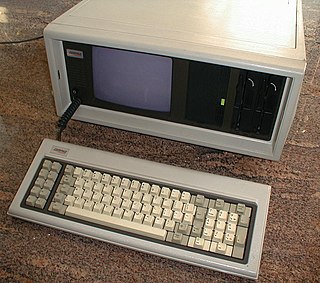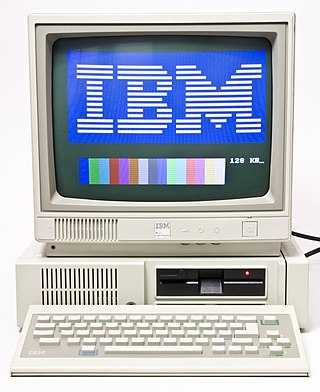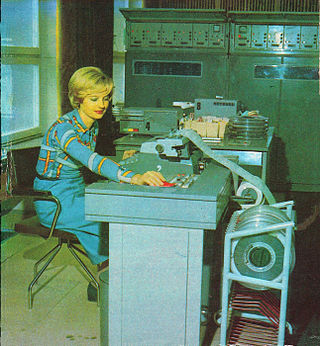
The IBM Personal Computer is the first microcomputer released in the IBM PC model line and the basis for the IBM PC compatible de facto standard. Released on August 12, 1981, it was created by a team of engineers and designers at International Business Machines (IBM), directed by William C. Lowe and Philip Don Estridge in Boca Raton, Florida.

IBM PC–compatible computers are technically similar to the original IBM PC, XT, and AT, all from computer giant IBM, that are able to use the same software and expansion cards. Such computers were referred to as PC clones, IBM clones or IBM PC clones. The term "IBM PC compatible" is now a historical description only, since IBM no longer sells personal computers after it sold its personal computer division in 2005 to Chinese technology company Lenovo. The designation "PC", as used in much of personal computer history, has not meant "personal computer" generally, but rather an x86 computer capable of running the same software that a contemporary IBM PC could. The term was initially in contrast to the variety of home computer systems available in the early 1980s, such as the Apple II, TRS-80, and Commodore 64. Later, the term was primarily used in contrast to Apple's Macintosh computers.

The Hercules Graphics Card (HGC) is a computer graphics controller formerly made by Hercules Computer Technology, Inc. that combines IBM's text-only MDA display standard with a bitmapped graphics mode, also offering a parallel printer port. This allows the HGC to offer both high-quality text and graphics from a single card.

The IBM PCjr was a home computer produced and marketed by IBM from March 1984 to May 1985, intended as a lower-cost variant of the IBM PC with hardware capabilities better suited for video games, in order to compete more directly with other home computers such as the Apple II and Commodore 64.

Odra was a line of computers manufactured in Wrocław, Poland. The name comes from the Odra river that flows through the city of Wrocław.

International Computers Limited (ICL) was a British computer hardware, computer software and computer services company that operated from 1968 until 2002. It was formed through a merger of International Computers and Tabulators (ICT), English Electric Computers (EEC) and Elliott Automation in 1968. The company's most successful product line was the ICL 2900 Series range of mainframe computers.

ES PEVM was a Soviet clone of the IBM PC in the 1980s. The ES PEVM models lineup also included analogues of IBM PC XT, IBM PC AT, IBM XT/370.

Jacek Karpiński was a Polish pioneer in computer engineering and computer science.
The Amiga computer can be used to emulate several other computer platforms, including legacy platforms such as the Commodore 64, and its contemporary rivals such as the IBM PC and the Macintosh.
Pravetz is a brand of personal computers produced in Bulgaria from 1979. They were widely used in scientific organizations and schools until the 1990s.

Leading Edge Products, Inc., was a computer manufacturer in the 1980s and the 1990s. It was based in Canton, Massachusetts.

Following the introduction of the IBM Personal Computer, or IBM PC, many other personal computer architectures became extinct within just a few years. It led to a wave of IBM PC compatible systems being released.

Mera–Elzab Meritum – a family of Polish personal computers based on TRS-80 Model I with BASIC Level II. Manufactured in the 1980s by Mera–Elzab in cooperation with ITM company.
The ICL DRS was a range of departmental computers from International Computers Limited (ICL). Standing originally for Distributed Resource System, the full name was later dropped in favour of the abbreviation.
ICT 1900 was a family of mainframe computers released by International Computers and Tabulators (ICT) and later International Computers Limited (ICL) during the 1960s and 1970s. The 1900 series was notable for being one of the few non-American competitors to the IBM System/360, enjoying significant success in the European and British Commonwealth markets.

Elwro was a Polish company that manufactured mainframe and microcomputers from 1959 until 1989. Its plant was in Wroclaw. Computer models included Odra mainframe systems, and the Elwro 800 Junior microcomputer for education.

Marienbad was a 1962 Polish puzzle mainframe game created by Elwro engineer Witold Podgórski in Wrocław, Poland for its Odra 1003. It was an adaption of the logic game nim. Inspired by the discussion in the magazine Przekrój of a variant of nim in the 1961 film Last Year at Marienbad, named "Marienbad" by the magazine, Podgórski programmed the game for the in-development 1003 mainframe, released in 1963. The game had players opposing the computer in alternating rounds of removing matches from a set, with the last player to take a match the loser. As the computer always played the optimal moves, it was essentially unbeatable.















